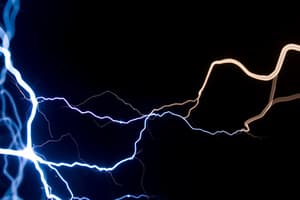Podcast
Questions and Answers
What is the intrinsic property of matter that causes it to experience a force when placed near other charged objects?
What is the intrinsic property of matter that causes it to experience a force when placed near other charged objects?
Electric charge
What are the two types of electric charge and how are they denoted?
What are the two types of electric charge and how are they denoted?
Positive (+) and negative (-)
According to Coulomb's law, what is the electrostatic force between any pair of point charges proportional to?
According to Coulomb's law, what is the electrostatic force between any pair of point charges proportional to?
The product of their magnitudes and inversely proportional to the square of the distance between them
Who first proposed the theory of charge being quantized and what are these discrete units known as?
Who first proposed the theory of charge being quantized and what are these discrete units known as?
When do like charges interact and what is the nature of their interaction?
When do like charges interact and what is the nature of their interaction?
When does an electrical field develop?
When does an electrical field develop?
What does Gauss's law state about the total amount of electric flux through a closed surface?
What does Gauss's law state about the total amount of electric flux through a closed surface?
How can Gauss's law be utilized to calculate the electric field generated by a charge distribution?
How can Gauss's law be utilized to calculate the electric field generated by a charge distribution?
What role do Coulomb's law and Gauss's law play in classical physics?
What role do Coulomb's law and Gauss's law play in classical physics?
What does the direction of the electric field vector quantity E indicate?
What does the direction of the electric field vector quantity E indicate?
How does a test charge moving with velocity v in an electric field experience a force?
How does a test charge moving with velocity v in an electric field experience a force?
Why is understanding electric charges and their behavior crucial in classical physics?
Why is understanding electric charges and their behavior crucial in classical physics?
Study Notes
Electric Charges and Fields
Understanding electric charges and their interactions through electromagnetic fields is fundamental to our grasp of electricity and its applications. This brief exploration will focus on two key concepts — electric charges and Gauss’s Law. By delving into these ideas, we aim to shed light on how nature behaves around charged particles and how this behavior can help us predict and shape electric phenomena.
Electric Charge
Electric charge refers to the intrinsic property of matter that causes it to experience a force when placed near other charged objects. There are two types of electric charge: positive (+) and negative (-), often referred to as protons and electrons, respectively, due to their presence in atoms. Like charges repel each other while oppositely charged attract. It was Gottfried Leibniz who first proposed the theory of charge being quantized; these discrete units are known as coulombs.
Coulomb's Law
Charged bodies exert forces on one another according to Coulomb's law, which states that the electrostatic force between any pair of point charges is directly proportional to the product of their magnitudes and inversely proportional to the square of the distance between them.
Electrical Field
An electrical field develops whenever there is an electric charge distribution. This invisible region surrounding charged particles exerts a force on other nearby charged particles, causing their acceleration along field lines extending from positively charged areas toward negatively charged regions. An electrical field is described by the vector quantity E, whose direction indicates where the field acts. A test charge moving with velocity v in an electric field experiences a force F = q*E.
Gauss's Law
One of the four Maxwell equations governing electricity and magnetism, Gauss's law tells us that the total amount of electric flux through a closed surface is equal to the net charge enclosed within it divided by the constant permittivity of free space (ε₀). Mathematically, this relationship can be expressed as:
[ \oint_{\Sigma} \vec{E}\cdot d\vec{\sigma}=\frac{Q_{enc}}{\epsilon_0} ]
This equation helps physicists calculate the electric field generated by a given charge distribution, apply principles such as superposition, and solve problems involving complex configurations of charges.
In summary, understanding electric charges and their behavior in various contexts forms the foundation of classical physics, allowing researchers to explain and manipulate myriad phenomena, from lightning storms to semiconductor devices. Through Coulomb's law and Gauss's law, we can describe and access powerful tools to model and control electric systems.
Studying That Suits You
Use AI to generate personalized quizzes and flashcards to suit your learning preferences.
Description
Explore the fundamental concepts of electric charges and fields, including the types of charges, Coulomb's law, electrical fields, and Gauss's law. Gain insights into how charged particles interact, the principles governing electric forces, and how to calculate electric flux through a closed surface. Delve into the foundation of classical physics and its applications in electricity and magnetism.




